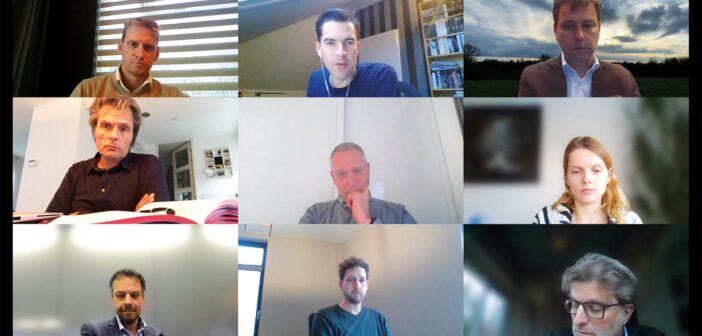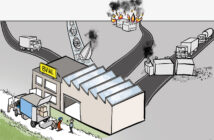Eight machine builders met digitally to discuss servitization revenue models. Although they operate in a variety of markets, such as semiconductor, dairy farming, tyre production, life sciences and road management, there was a great deal of mutual recognition. The participants in this meeting of the Servitization platform also learned a lot from each other’s approach to generate business from data from their installed base. At the same time, the conclusion was that building these revenue models is easier in some sectors than in others.
– ‘The key is to involve all the client’s stakeholders in the deal.’
– ‘Data on materials says a lot about the quality of processes.’
– ‘If you only base yourself on operating expenses, you will have covered only a fraction of the new machine price after five years.’
– ‘You really need a clear roadmap and release management.’
‘You only make progress if the client themselves experiences the need’
What value do you seek to create for your client? According to Arjan Ester, CEO of Aebi Schmidt, ‘a good answer to this question requires a proper understanding of the client’s pains and gains. With the data we receive from our grit sprinklers in the field, we can determine the optimum route for the client, for example. This type of added value enables client lock-in. To identify those needs, you need to be able to win over the client at various levels, so that you can gain a clear understanding of how exactly they use your machine.’
‘We approach the client’, adds his manager group solution development Joost Sterenborg , ‘at an operational, tactical and strategic level in order to achieve the most appropriate service. At a strategic level, it may be about circularity and cost efficiency, which calls for a USP that ensures that machines consume less salt and diesel. You need data for that, while the driver mainly values a good seat in the cabin.’ Ester: ‘The key is to involve all the client’s stakeholders in the deal you want to close with them.’
Working together in an ecosystem
Freddie Ruijs, senior product manager of farm management systems & data at Lely, manufacturer of milking and feeding robots: ‘Our farmers are mainly concerned with the percentage of fat and protein in their milk; that’s what the dairy manufacturer judges them by. So our robots need to provide this information. To this end, we are now seeking to collaborate with other suppliers in the ecosystem around the livestock farmer, such as the livestock feed supplier. They have information about the exact composition of feed. This enables our robots to measure which cow is ingesting what and how much milk of what quality this results in. A farmer will be prepared to hand over their data online if you can demonstrate that they can immediately adjust their processes in such a way that their cows will immediately produce milk that will earn them a higher margin.’ Ruijs’ experience is that it helps if this service, for which the farmer has to pay monthly, is accompanied by hardware in addition to software. ‘A farmer likes to have something physical in their hands, a sensor for example. That instils more confidence than non-tangible software alone.’

‘A farmer will be prepared to hand over their data online if you can demonstrate that they can immediately adjust their processes in such a way that their cows will immediately produce milk that earns them a higher margin’, says Freddie Ruijs of milking robot manufacturer Lely. Photo: Lely
Provide evidence
‘It’s a long-term process,’ continues Ruijs. Use sensor data to create so much extra added value that the client realises that without it, the product is of little use to them.’ Compare it to a Tesla driver, for whom their car is worth much less if they have no up-to-date map of charging points. ‘For us this means that we have to involve as many players as possible in that ecosystem, including the dairy manufacturer. So that you can show the farmer that, if they themselves can check with data that their cows have spent a certain amount of time in the pasture, their milk can be branded at a higher price as ‘pasture milk.’
Protecting data
Joris ten Thije, program manager service innovation at Thermo Fisher Scientific, manufacturer of electron microscopes, finds it difficult to transfer this way of working on servitization revenue models to his semiconductor world. ‘Our life sciences clients are willing to pay for data and advice, especially if this prevents maintenance work and downtime. Our semiconductor clients in Asia, however, do want the data, but do not need it to be processed into advice, let alone pay for it. Their specialists are perfectly able to extract useful information and value from that data themselves. Investing in that is a risk for us.’ Jeroen Slobbe, COO of tyre manufacturer VMI, has the same experience: ‘Our major clients buy the monitoring functions and shield the data from them. So we’re still not always able to work with other parties in the ecosystem.’
Sterenborg: ‘Some of our clients don’t use our applications and consider themselves capable enough to translate machine data into information. We then provide them with raw data. That’s why we use different revenue models for data, so we can support the client at different levels.’
Share only locally
Chris Sanders, service product manager at ASML, confirms Ten Thije’s story. ‘In our world, it’s hard to get data from the chip factory. Sometimes it is ‘never waste a good crisis’. In this coronavirus time, we were suddenly able to get a camera into a client’s factory for the installation of new chip machines, so that our engineers could help remotely with the installation. But getting the on product process data to Veldhoven is difficult, especially given the client IP in the data. That data has to stay there in the factory. They are willing to share it with us locally in order to carry out planned maintenance together, but that’s as far as it goes. I think you will only make progress if the client themselves experiences the need. But then they have to give you the opportunity to show that you can do more with it than they can, and more cost-effectively.’
‘If the client sees the added value, you will get their data’
Staying in the middle
‘In these kinds of situations,’ Slobbe adds, ‘it’s an advantage if you’re a leading player in the market, as we are with our tyre production machines. Yet our clients are also very reluctant to share their data. Data on materials says a lot about the quality of processes. If we can get that data from the client’s MES system and label and analyse it, we can use it to improve our machines, creating room for new service revenue models. If the client recognises the added value of that, you’ll get their data.’ ‘But you have to make sure,’ says Ten Thije, ‘that you stay in the middle. Sell it as a service package with training, add hardware sensors. Prevent the client from being able to process it all themselves into information that makes sense to them.’
Which brings Slobbe to another concern: ‘Our major component suppliers who want to integrate vertically are developing more and more technology that generates data for service purposes. Besides the fact that the client does not want to give that data, you may also have to deal with – often large and powerful – suppliers who contact the client themselves to offer service, skipping you. The client likes that: they prefer to make their data available only in a centralised ecosystem. We are therefore looking whether we can develop more of our own embedded software.’
Platform for the entire ecosystem
In short, the client wants to distribute data and rule themselves. That is why it is important to work on a software platform, says Ruijs, on which the entire ecosystem can run its own applications. ‘This means that other parties in the ecosystem need to realise that it is becoming very expensive to develop and maintain apps independently and that it is difficult to recoup the investment on your own. We hope to create a platform where every player has their own domain with their own data, which they obtain for a certain amount of money to provide up-to-date advice themselves. A step further is that you and the other parties combine their data streams with yours, using the patterns to gain new insights that you can’t get with your own data alone. Each party in that ecosystem can then have their share of a larger servitization revenue model.’ Lely colleague and senior project manager Oscar Moers, says: ‘As a result, the farmer only has to work with one piece of software to obtain all the information. But it is important that the data always remains the property of the farmer.’
Billing per wafer?
In his own semiconductor business, Sanders does see a future in selling predictable uptime and/or good-wafers-out. ‘We are bringing more and more measuring equipment into the factory to check the quality of the chip machine. We sell this as a feed-forward mechanism to improve the wafer quality in-line. It is then important to conclude multi-year framework agreements with the client at the highest level about supplying a certain amount of good-wafers-out and/or predictable uptime for an amount that is linked to the selling price. However, it is difficult to link the right service KPIs to this that are attractive to both us and the client. Billing per wafer is possible, but probably not for all factories. Making unlimited parts and service time available, linked to the opex (operating expenses, ed.), is not attractive either. If you only base yourself on operating expenses, you will have covered only a fraction of the new machine price after five years. So you will also have to include the capex, the purchase value. We’re not there yet.’
Iron discipline
Sanders asks the other participants how to deal with continuous improvements with clients who prefer to settle everything on the basis of capex. Ruijs: ‘We’re working on converting some of those types of services into subscriptions and gradually broadening those. Clients can choose from low and high service levels, but must purchase at least a basic level, otherwise they won’t get that software. We hope that with added value we can live up to those higher levels and expand in time. We are also aiming to increase the opex component in order to make the client gradually realise that it is normal to pay for these costs. And that not everything is in those first purchase costs anymore.’
Roadmap
VMI has the same problems, Slobbe says. ‘As an innovation leader you tend to follow the engineers, and service always comes after it. You really need a clear roadmap and release management. That requires iron discipline. Sometimes it is difficult to manage the product lifecycle, because we also have to manage releases in the service domain and not everything is backward compatible.’
Linking product lifecycle management and service lifecycle management is high on the wish list, but its implementation is still in its infancy, says Slobbe. ‘Our engineering is mainly looking forward and is not necessarily properly linked to the service lifecycle. Such a product lifecycle easily spans fifteen to twenty years, during which many changes in process and product quality take place. As VMI, we’re paying more and more attention to lifecycle management for more client value across the lifecycle. That’s why our machines have a fixed base and modular construction, which facilitates upgrades or repairs.’
Lifetime extension

Theo Kneepkens
(KLA) about supercycle of growth: Í hope that supply industry expands its capacity’. Read this edition of link magazine digitally via this link
At ASML, the product lifecycle even spans thirty years. Sanders: ‘The cost level that our clients find acceptable is declining over the years. There are also end-of-life issues, which increase maintenance costs. For ASML, the link with service is still fresh; our new lifecycle policy is now being worked out. We want to offer clients a certain service at a certain price for ten years. After that, they can buy a lifetime extension package, depending on the machine. We want to prevent clients from having machines repaired by others because we no longer offer that service. At ASML, we want to keep control of the entire ecosystem. So if at all possible we’ll continue with a product.’
Ten Thije says: ‘Sometimes clients are willing to pay a lot to keep systems alive. That can be interesting, up to the point where you need R&D to make replacement parts.’ That is why Aebi-Schmidt works with refurbishment programmes. Ester: ‘Clients use the machine for ten, twelve years and can have an upgrade or re-manufacturing during its lifetime. That way you get business from the machine lifetime and even from the period after the original end-of-life.’
Servitization platform
Participants in the Servitization platform include manufacturing companies and two knowledge institutions, including TU Eindhoven, initiator together with Link Magazine. The higher goal of the initiative is to make (many) more companies in our country aware that servitization is an important enabler of future continuity and profitable growth. This involves the transition from selling products to delivering and maintaining product service systems (service solutions). A platform of frontrunners stimulates this awareness and accelerates the development of smart services that will generate new business. The platform is designed in such a way that it can help companies to analyse their organisation, to map out a basic strategy, to formulate concrete projects and then to develop and roll out concrete new services. By discussing concrete projects in the platform, the transition of these companies to servitization can be accelerated.
For more information about the platform, please contact j.n.v.ginkel@tue.nl
www.escf.nl






